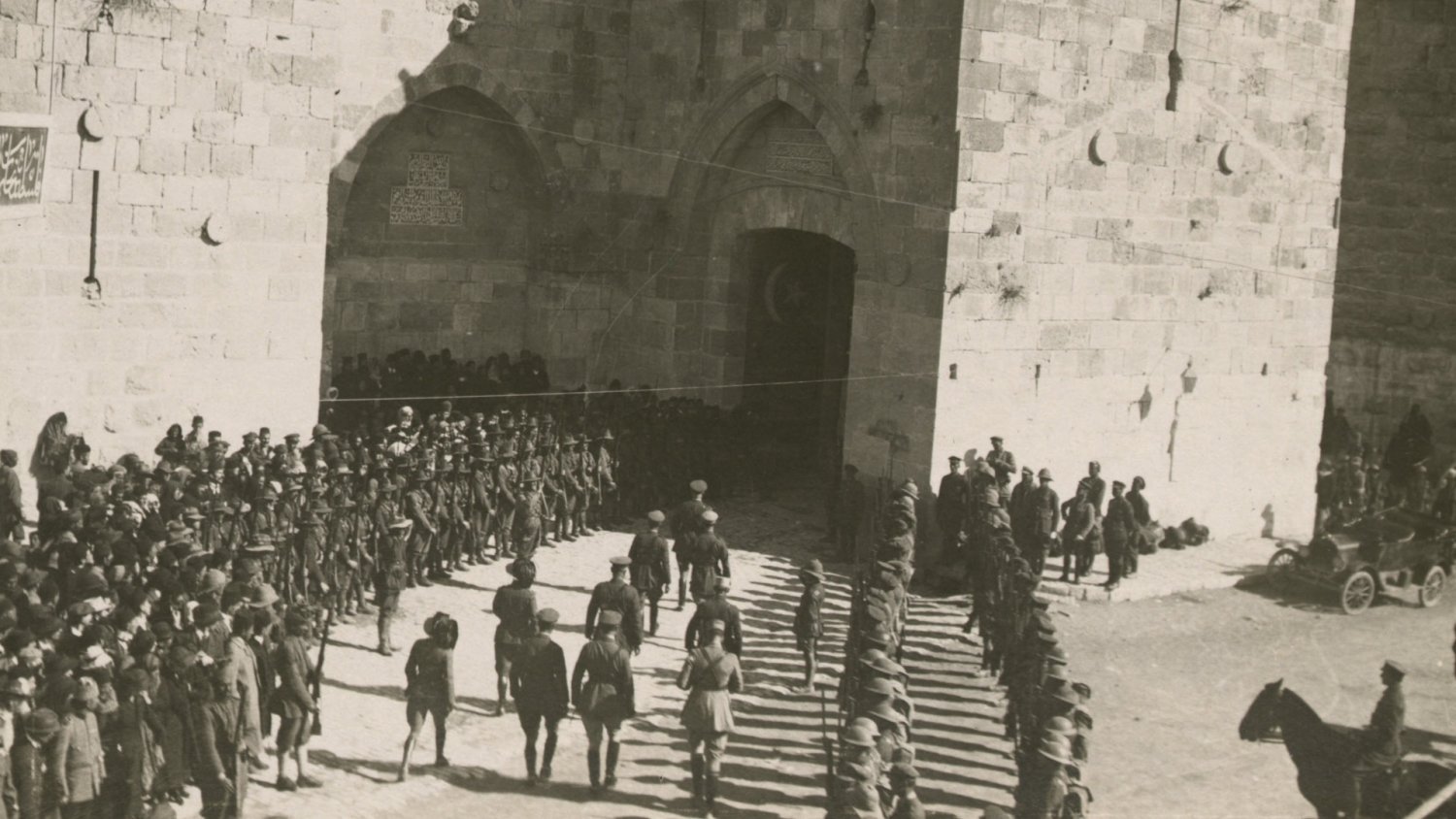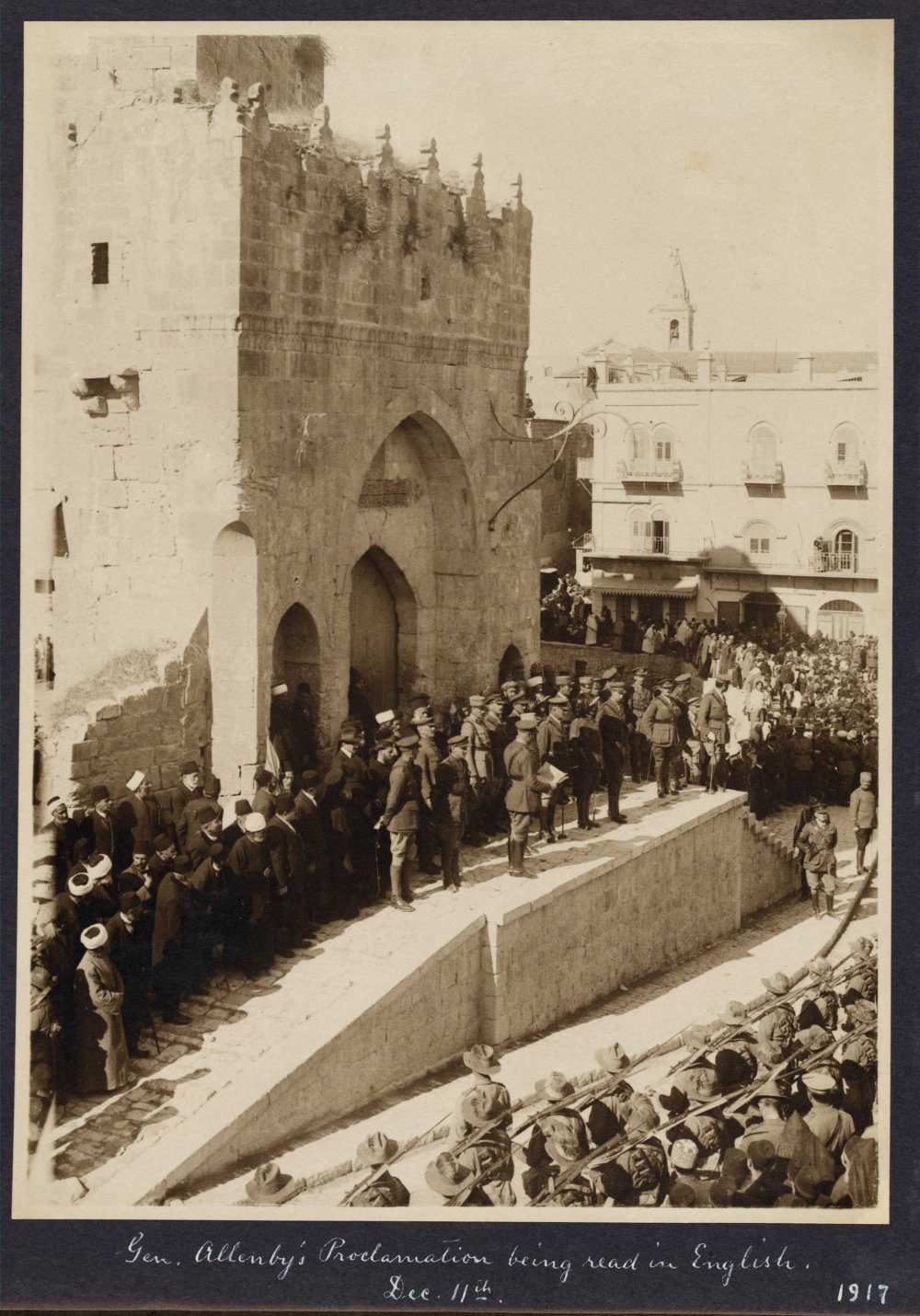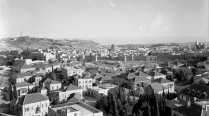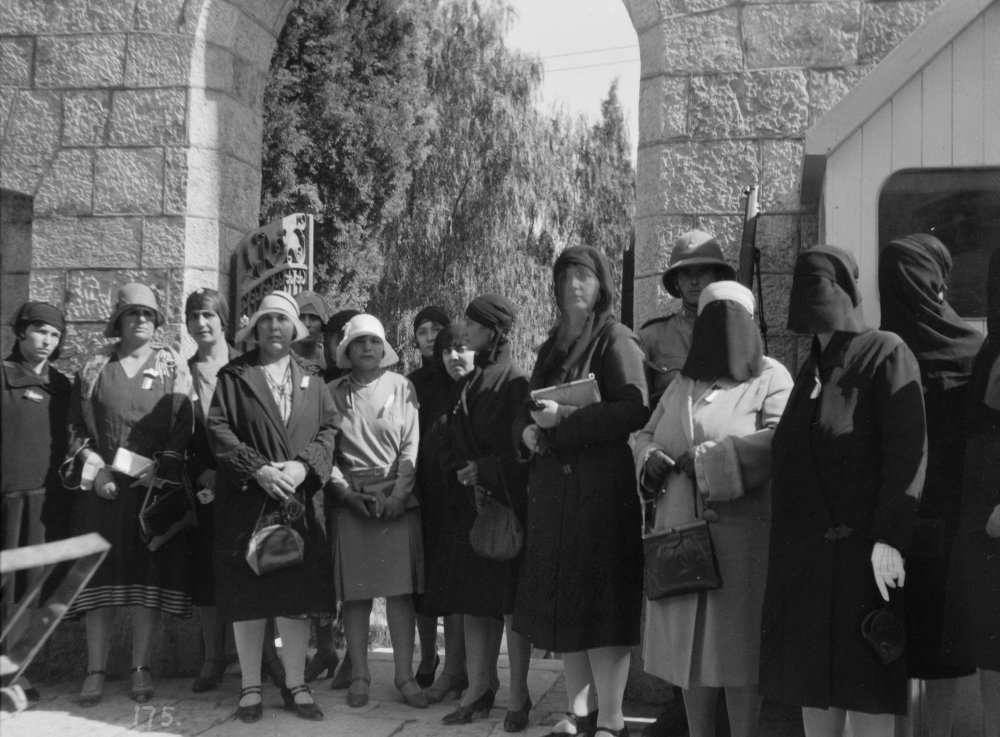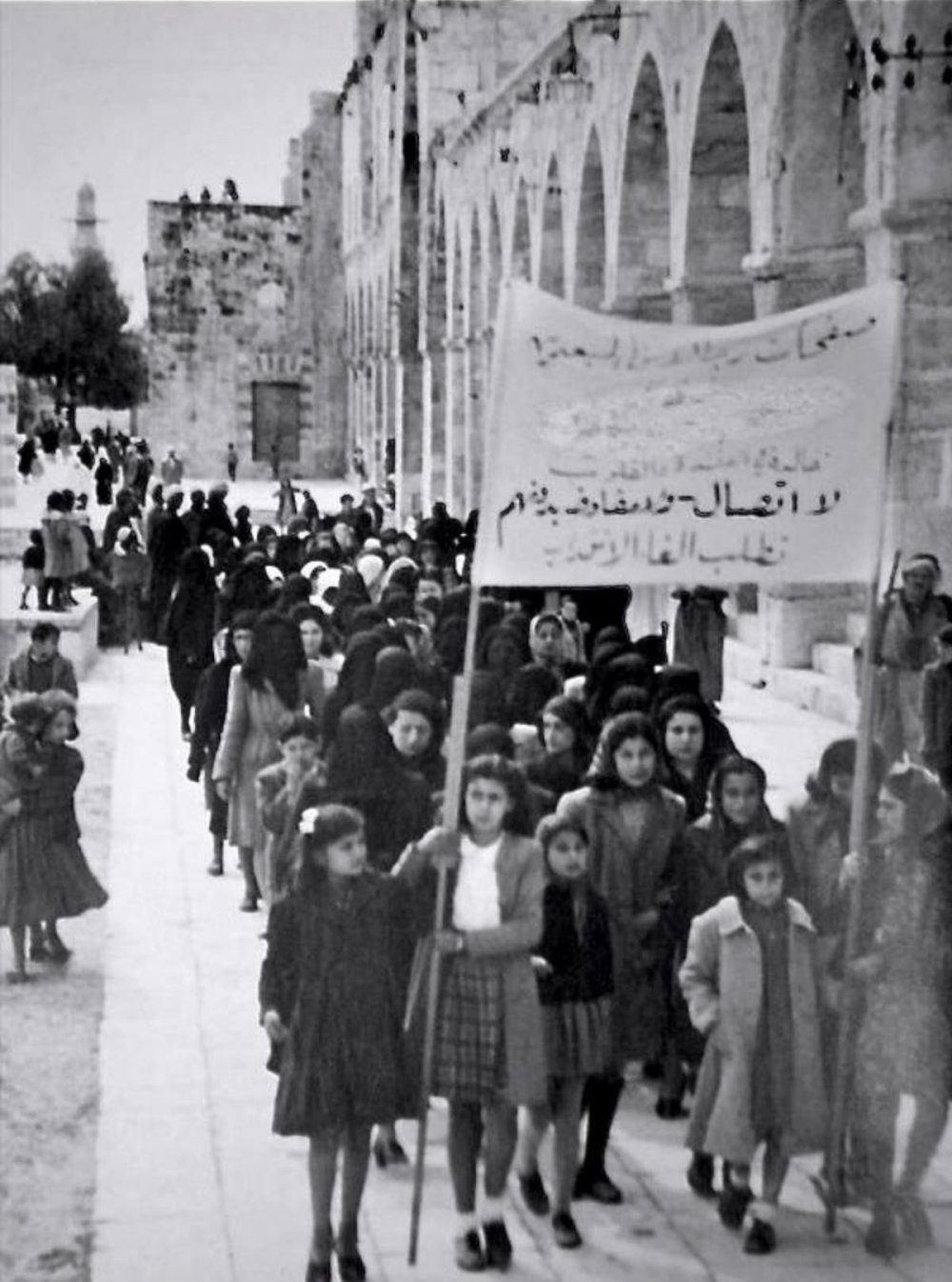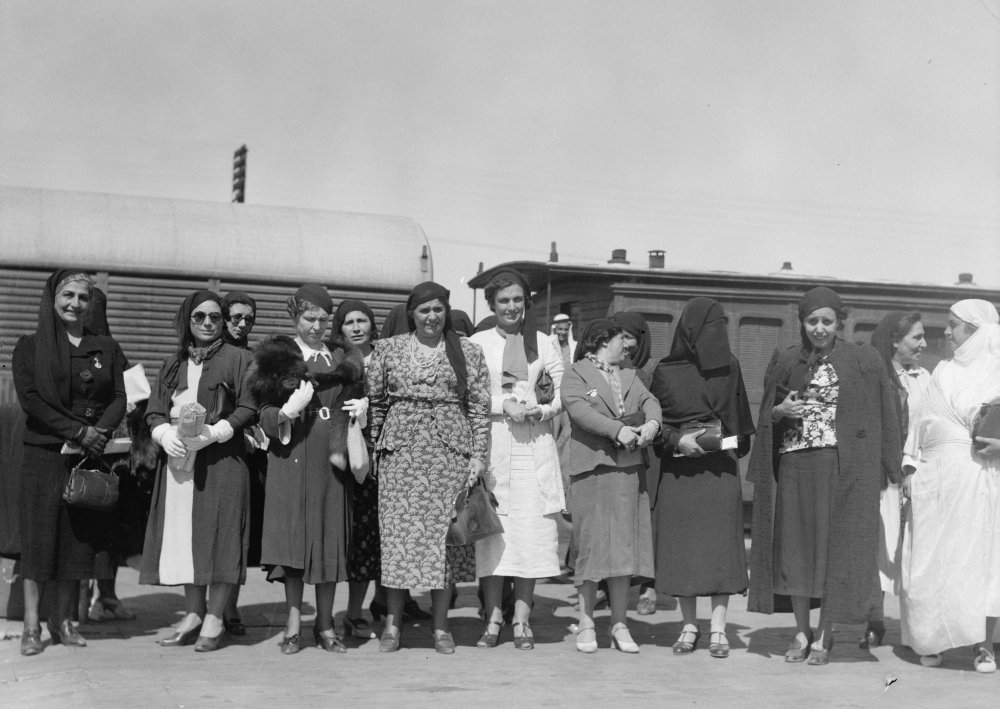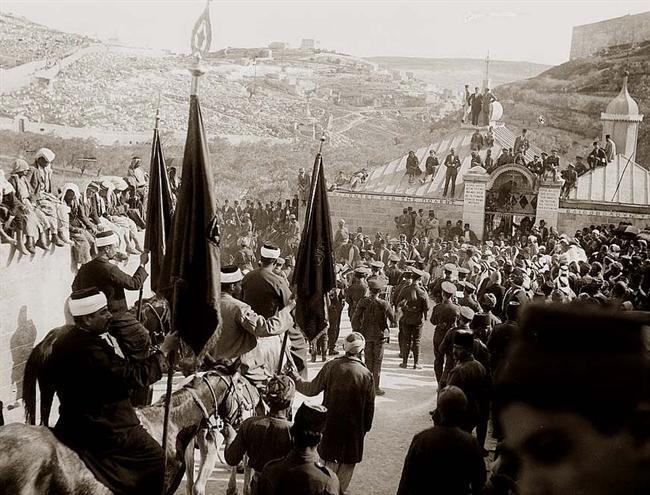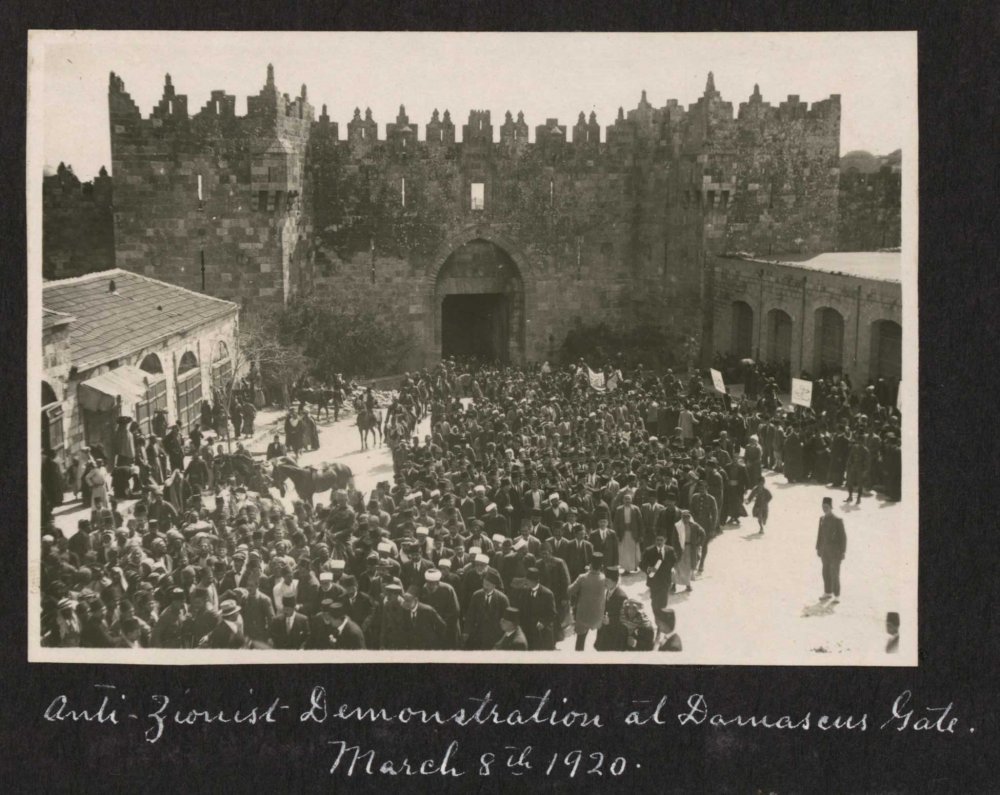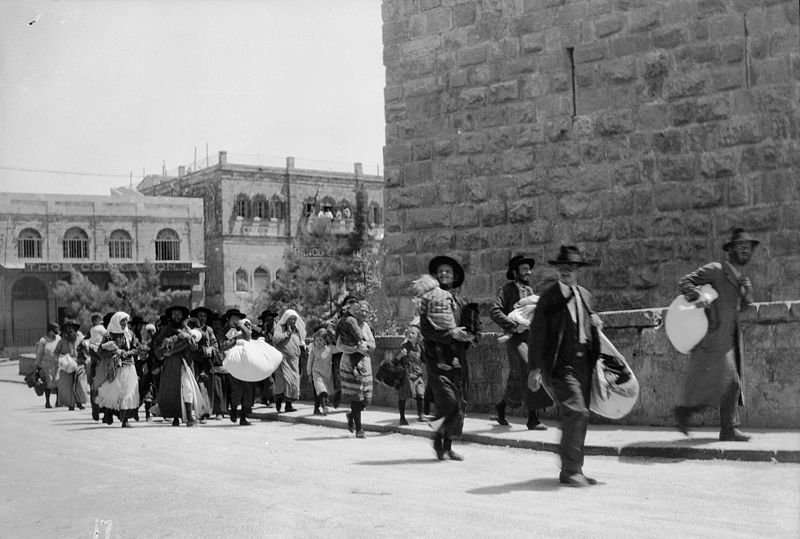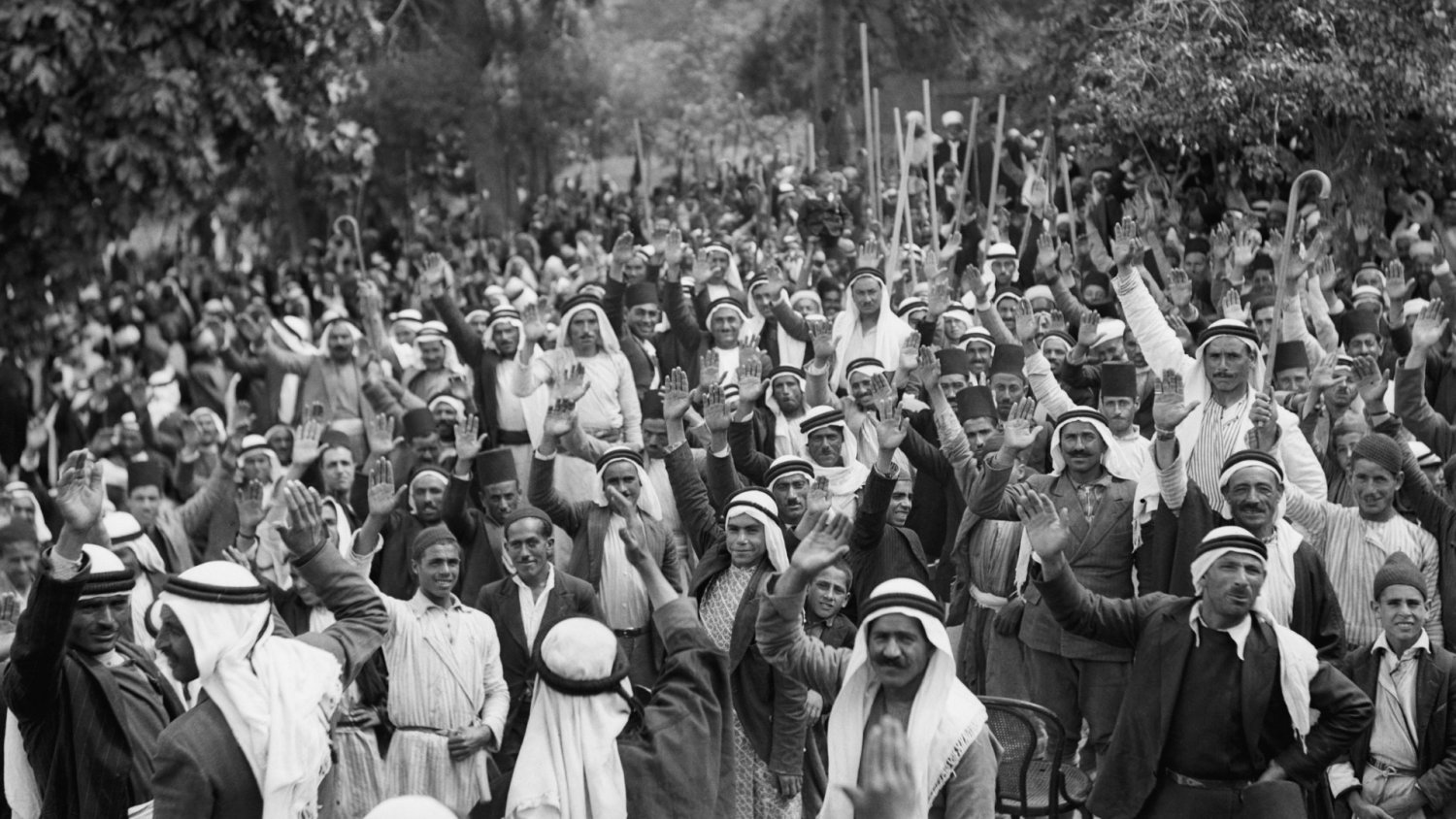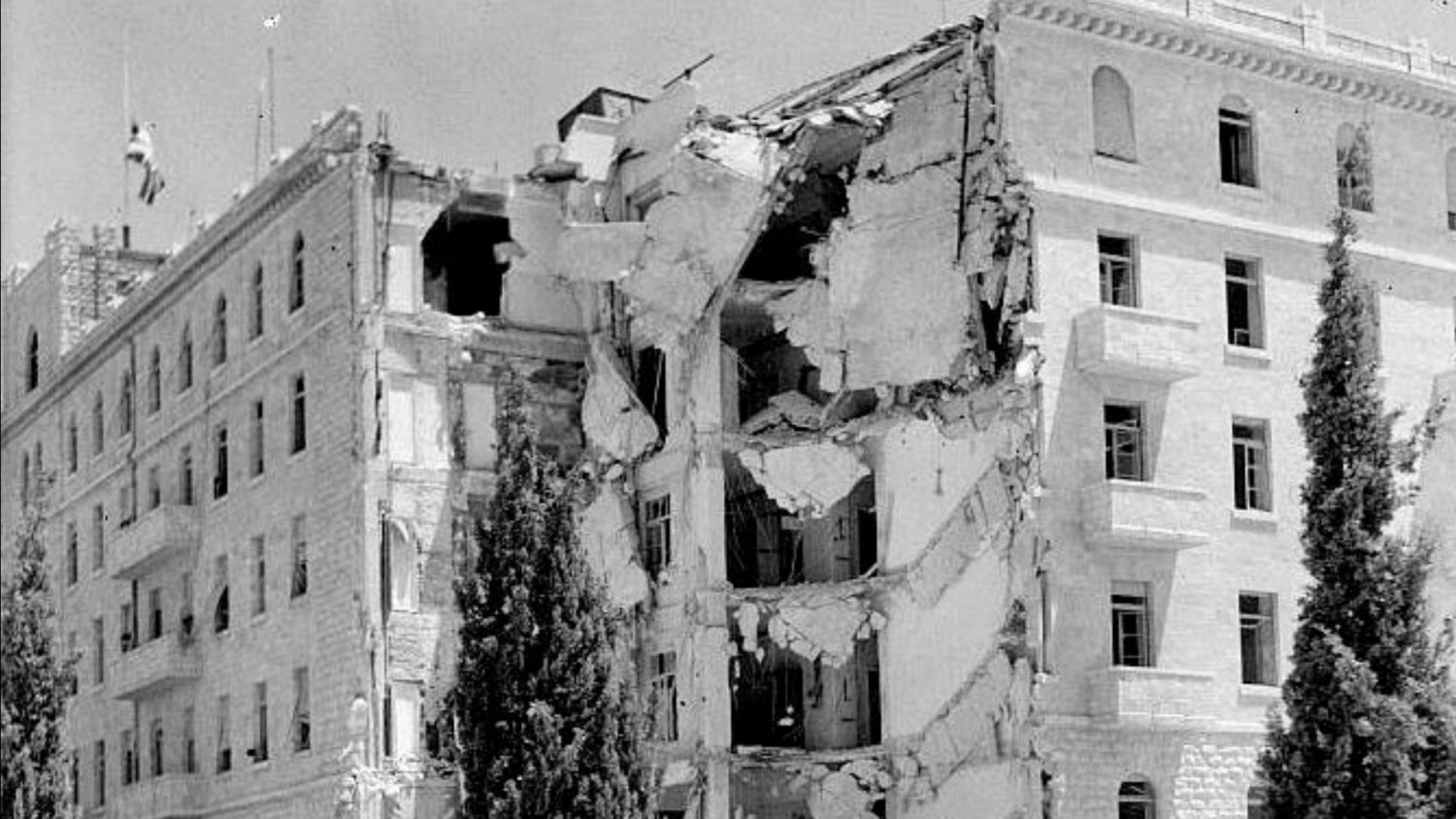The Transformation of the City under British Rule
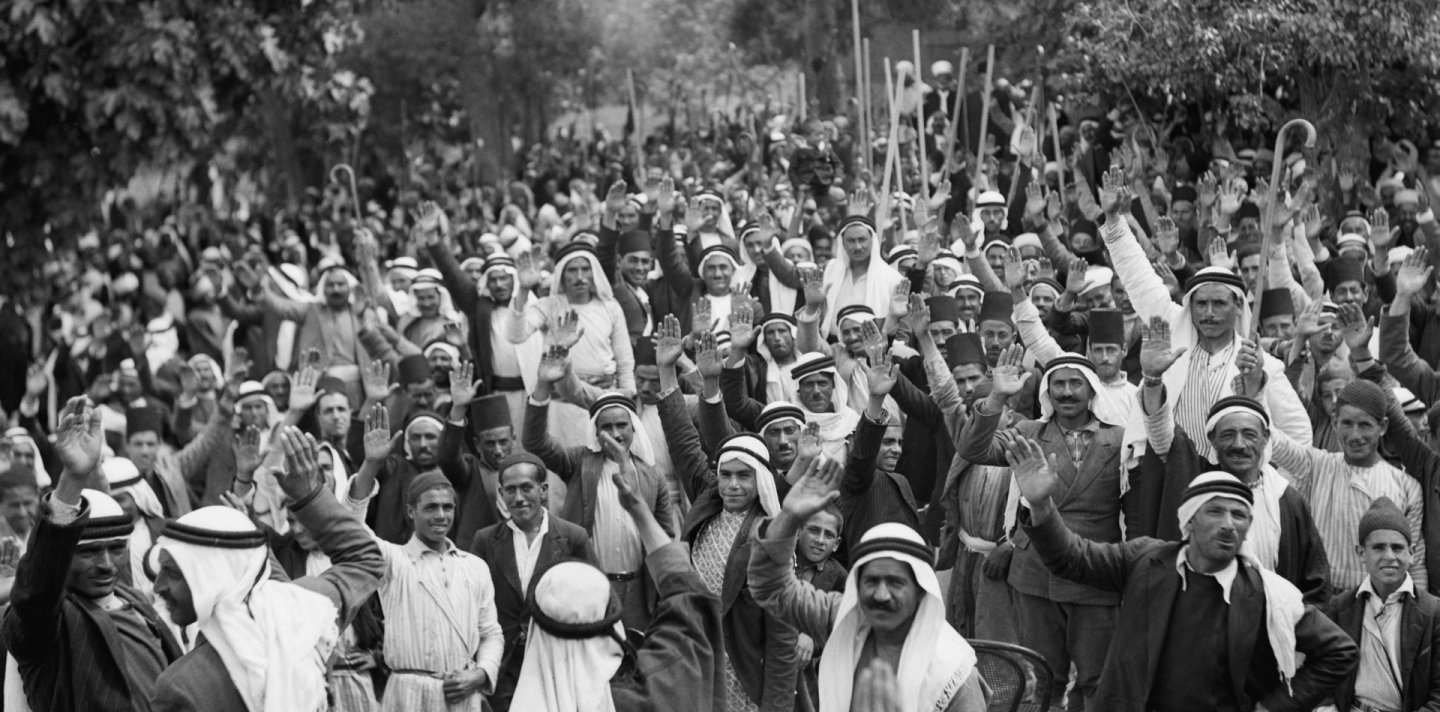
Credit:
Alamy Stock Photo
The West Side Story, Part 2: The Darkening Horizon: Jerusalem’s New City under the British Mandate
Snapshot
Following the arrival of British forces into Jerusalem in December 1917, and the subsequent establishment of the British Mandate in 1922, Britain began laying the groundwork for creating a “national home” for Jews in Palestine. This entailed ensuring the continued in-migration of Jews to Palestine, as well as the allocation of Palestinian lands to increasingly self-isolating Jewish communities. With the rise in Palestinian resentment toward British policies, and after several Palestinian rebellions throughout the interwar period, Zionist leaders formed paramilitary groups that carried out attacks on the British and Palestinians throughout the city. The situation rapidly deteriorated into civil war starting in late 1947 until May 1948, with disastrous results for the Palestinians of the New City.
This Backgrounder sketches what happened to the New City and the Palestinians who lived in it under the British Mandate; Part 3 chronicles the chaos that ensued as the country spiraled into civil war. The focus is on the lived experience of Palestinians and on the origins of Jewish West Jerusalem, and not on reconstructing a full history of the Mandate or the war. Those stories have been amply documented elsewhere.
Part 2 of a four-part series. View Part 1 here, Part 3 here, and Part 4 here.
British forces, under General Edmund Allenby, marched into Jerusalem on December 11, 1917, occupying it for three years until it was officially granted to Britain as a mandate by the League of Nations on April 25, 1920.
Over the course of the 1920s, Jerusalem expanded in population and character, especially with regards to its relationship with neighboring villages. The western villages of Lifta, ‘Ayn Karim, al-Maliha, and Deir Yasin became central to Jerusalem’s social, political, and economic fabric. Indeed, these villages, directly to the west of the city center, witnessed major changes because of their strategic locations close to the main Jaffa-Jerusalem road and to the expanding Zionist colonies in their immediate vicinity.1
Copy of the Letter of Surrender to the British
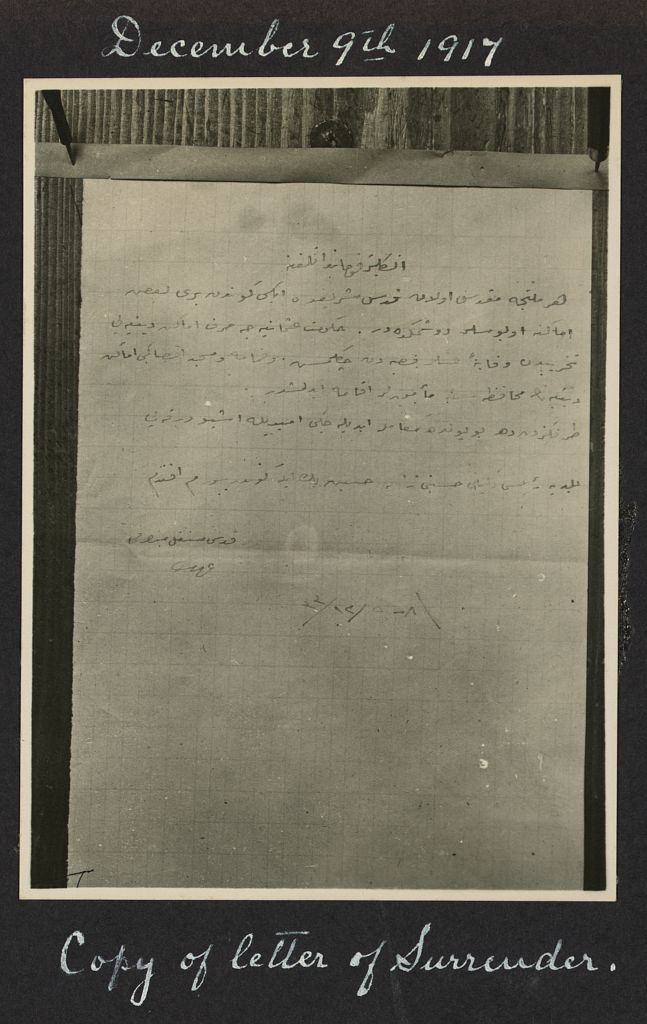
Source: Library of Congress, Prints and Photographs Division [matpc 02222]
Original handwritten copy of the letter of surrender of the city to the British, December 9,1917
As the British established direct administrative and colonial control in Palestine, they ushered in tumultuous socioeconomic, political, and demographic changes.2 On the one hand, after suffering the consequences of World War I, the new administration promised improved services, economic growth, and stability. On the other, and even before the Mandate officially began in 1922, the British promised to see to the establishment in Palestine of a Jewish “national home.”
In a letter dated November 2, 1917, Arthur Balfour, British foreign secretary, made this promise to Walter Rothschild of the Zionist Federation of Great Britain and Ireland. The promise, known as the Balfour Declaration, was made a month before Britain’s military occupation of Palestine, and it ensured the immigration of hundreds of thousands of Jews to Palestine throughout the Mandate, permanently disrupting life in Palestine and altering Jerusalem’s diverse and cosmopolitan identity.3
Proclamation of Martial Law in Jerusalem
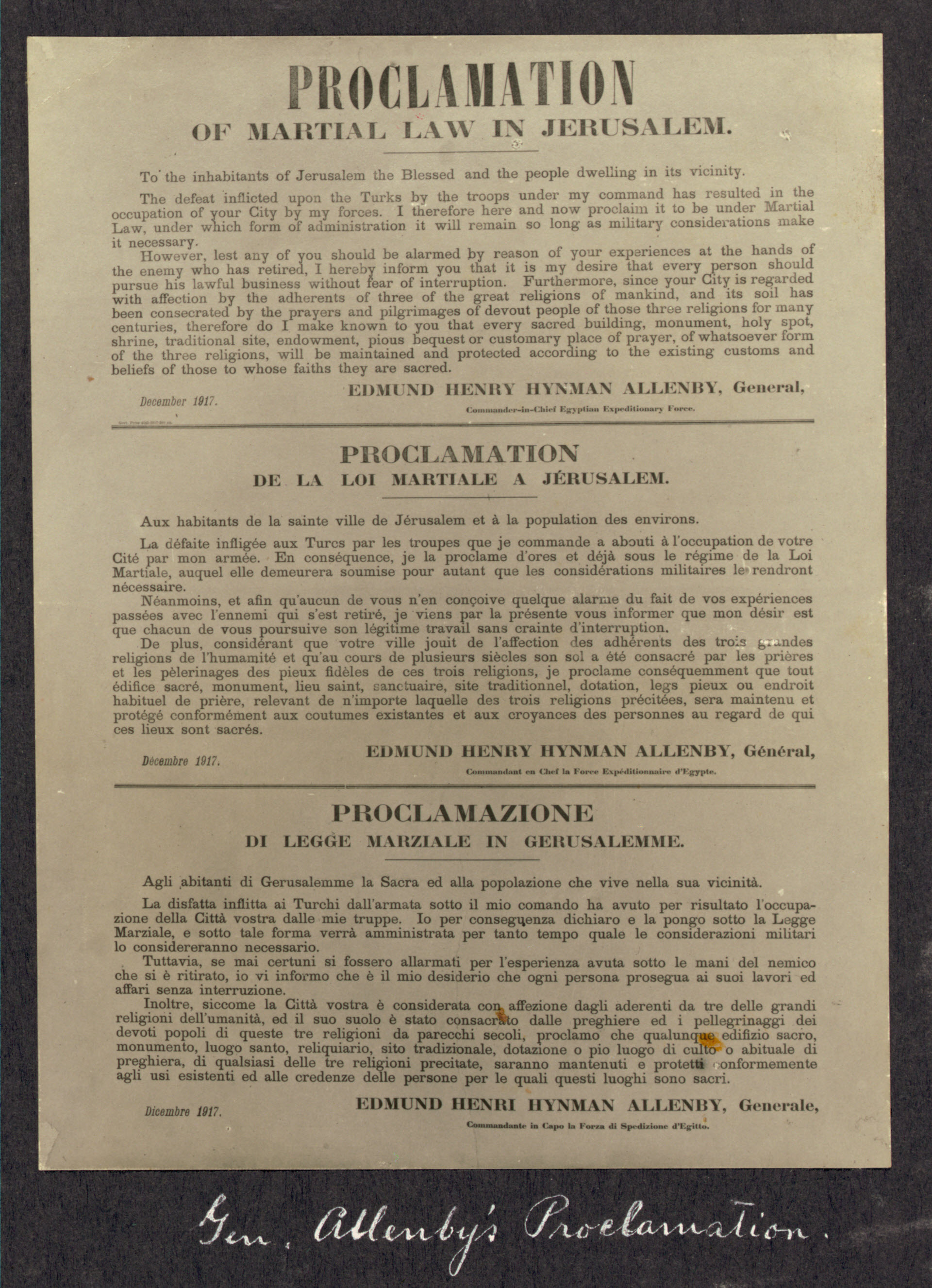
Notes
Credit: Library of Congress
The actual proclamation of martial law as declared by General Allenby on December 11, 1917
Self-separation: A Zionist strategy
Jerusalem’s New City was built to be a religiously and ethnically diverse and cosmopolitan part of the city that hosted a variety of social, religious, and political institutions.4 Adjacent neighborhoods of the New City saw Arabs and Jews living peacefully, connected through economic ties and even real estate. Indeed, Palestinians in the New City would rent their homes—or sections of them—to non-Arabs, including Jews and migrants from inside and outside Jerusalem.5
With the rise of cultural modernity and globalization in Jerusalem, the city witnessed the emergence of mixed communities in middle-class neighborhoods such as Romema, Shamma, and Musrara.
These communities were not mixed only across religions, but also across ethnicities. While the Jews in cities like Hebron and Tiberius spoke Arabic, middle-class Jews in Jerusalem were mostly European immigrants.
During the Mandate period, many Jews born in Jerusalem to families of European origin did not speak the language of the local community. These Ashkenazi Jews are imprinted in the Palestinian collective memory as the ones who separated themselves physically, culturally, and linguistically from the local Palestinian Arab population.6
The Arab population of the New City (and Jerusalem in general) was not static. Many migrated from across the country to attend prestigious colleges and boarding schools, to seek employment—especially during the British Mandate—and even to marry.7 The Jerusalem elite fled the summer’s heat by visiting the breezy coastal beaches, and the cold winter months by relocating to their second homes in Jericho and the Jordan Valley. Wealthy Palestinian Jerusalemites were indeed cosmopolitan.
Constructing a life side by side in the new and old cities of Jerusalem, the Arab population saw themselves as one, including Arab Jews, who were considered to be “good neighbor[s].”8 But this dynamic changed in the 20th century with intensive Zionist migration and the political escalation that came with the transition from Ottoman to European rule, starting with the British occupation in 1917. Where previously “Palestinian” referred just as much to Jews as to Arabs, now gradually the identity of the “Arab” came to mean the Palestinian Christians and Muslims, as opposed to Palestinian Jews, who, after the influx of European Jews into Palestine during the interwar period and the subsequent revolts by Palestinians, started identifying with the Zionist movement and distancing themselves from Palestinian Arabs.9
Arab Christians and Muslims found themselves united against British Mandate authorities, who were promoting Jewish migration to Palestine, as well as the Zionist plan to establish a national home for the Jews in Palestine. The newspaper al-Quds al-Sharif, run by the Dajani family, an elite Palestinian Muslim family in Jerusalem, echoed this theme in some of its articles that described how the Jewish population had backed the invaders against the Christians and Muslims of Palestine. An article by al-Mira newspaper featured in al-Quds al-Sharif stated that the threat of the Zionist invasion is a threat to both Muslim and Christian Palestinians.10
It is important to point out that plans to isolate and privilege the Jewish minority of Palestine were already underway by the time of the 1917 Balfour Declaration. Starting in the 1880s, and with the increasing influence of the Zionist movement across Europe, the Jewish population of Jerusalem began to separate from the Arab population. This was most evident in the construction of neighborhoods and buildings in the New City intended to house Jews exclusively.11 The separation was reinforced in an institutional manner following the establishment of the British Mandate in 1922. Herbert Samuel, the first high commissioner in Palestine and a staunch Zionist, issued over 100 ordinances that established separate Jewish banks, schools, political bodies, unions, and even security forces, which would later grow into the Haganah.12
This behavior of self-separating among the Jews of Jerusalem persisted throughout the Mandate period. During October 1934, for example, there were efforts among the Jewish population of Jerusalem to have a Jewish mayor in the New City municipality. Jewish residents formed a separate municipal committee for Jewish matters.13
During British rule, the Jewish population also insisted on creating a segregated educational system intended to educate Jewish children exclusively.14 While Jews had joined Muslim and Christian students in many European schools that were established to host European migrants’ children, few Jewish children were enrolled in these private schools following the segregation of the school system. This had the adverse effect of reducing cultural, religious, and ethnic intermixing, leading to the further isolation of Jerusalem’s Jewish population.
A few months after the Balfour Declaration, the Zionist Federation in England sent a commission to Jerusalem to examine the suitability and livability of the city for the arrival of Jews. In May 1918, Chaim Weizmann, president of the federation, wrote to Arthur Balfour bemoaning the “miserable dirty cottages and derelict buildings” in the vicinity of the Western Wall. In the letter, he set a goal for Jews to liberate the city from “the hands of some dubious Moghreb religious community.”15
The subsequent efforts of Ronald Storrs, the first British governor of Jerusalem, and the Zionist commission to purchase property from the Muslims in the Old City were condemned by Kamal al-Husseini, the mufti of Jerusalem. These efforts were summarized as follows:
A Jew of prominence approached certain of the Muslims interested with a pecuniary offer. Muslim opinion thereupon became seriously agitated and instructions were received from the Foreign Office that the matter should not be pursued for the time being.16
Arab political groups in the city joined the protest against any change in the status of the Old City and demanded the immediate establishment of an independent Arab Palestine.
Despite the temporary stall in the plan to “liberate” the Western Wall, Zionists’ concern over the holy site was kept alive by members of Vladimir Jabotinsky’s Jewish battalion, which staged provocative marches to the wall and instigated fights with the Arab population.17 These attempts to control the city’s holy sites continued throughout the Mandate years by several members of the British Zionist Federation, although Jabotinsky gradually shifted his interest to maximizing Zionist political objectives, including establishing a regular Jewish army in Palestine and gaining British approval for the Zionist colonization of Trans-Jordan.18
Other members of the federation stimulated hope among international Jewish communities that Jewish religious sites in Jerusalem could be “liberated.” During the first year of British civil rule in Jerusalem, the New York Times posted the Zionist tourist card on which Theodor Herzl was positioned next to the Dome of the Rock, over which the Zionist flag was flying.19
A Hub of Political Activism and Violence
Jerusalem was rapidly transforming under British rule, especially in the localities of its western side, where Jewish settlement was increasing. As British Mandate authorities chose Jerusalem as their administrative capital, it also became the hub of anti-colonial national activism among the city’s locals.
Emergence of popular politics
During the 1920s, a new form of popular politics emerged that saw the Arab population establishing popular organizations and creating new forms of mass mobilization. Various types of youth organizations and movements sprung up, which were one of the foundational bases of the new organizational politics.20
Women’s political activism also emerged, infused with a strong sense of national political identity.21 These feminist movements, such as the Palestine Arab Women’s Congress, were founded by educated women from wealthy and well-established Jerusalem families. They worked on empowering less fortunate women and girls across the country and led political and anti-colonial campaigns.22
Much of this activism centered on the British commitment to the Zionist agenda. Palestinians knew that the Mandate’s priority was to serve the Zionist goal of establishing a Jewish national home in Palestine. They expressed this in newspapers and other publications. For example, in 1920, al-Mira published the following excerpt, which was republished in al-Quds al-Sharif:
It is not a superstition that the whole of Palestine is shaken by its separation from Syria . . . and it is afraid of the danger of Zionism and what comes with it—which is that Muslim and Christian Palestine is threatened with death and extinction.23
A series of eruptions
Throughout Britain’s 30-year occupation of Palestine, over 400,000 Jews immigrated to Palestine and received Palestinian citizenship, including the benefits associated with being the favored subjects of the British Government of Palestine.24 Most perniciously to Palestinians, British authorities confiscated many of their properties and lands and sold them to incoming Jews. As a result, Palestinians rose up against British rule in different instances, including during the 1920 Nebi Musa riots, the 1929 Buraq Uprising, and the Great Palestinian Revolt of 1936–39.
Nebi Musa Riots
The annual, week-long Nebi Musa festival was a famous Muslim tradition in Palestine where pilgrims gathered in Jerusalem and journeyed to the mausoleum of the Prophet Moses near Jericho. It began on the Friday before Good Friday in the Greek Orthodox calendar. Hala Sakakini described it at the time:
A major festive event was the Moslem al-Nabi Musa feast, which always coincided with the Easter Holy Week. Peasants from all over Palestine took part in it and made it most colourful. . . . At the head of the procession would be the Mufti of Jerusalem riding a horse and carrying the banner of al-Nabi Musa. A huge crowd would have gathered just outside St. Stephen’s Gate to welcome them back.25
But with the impending British occupation of Palestine and the rise in Zionist influence there, between Sunday, April 4, and Wednesday, April 7, 2020, the Old City of Jerusalem became the site of intense riots which left five Jews and four Arabs dead.26
On the morning of Sunday, April 4, a large crowd of Arabs gathered in the city center to commence the festival celebrations. Prominent Palestinian nationalist Amin al-Husseini and his uncle Musa al-Husseini, the mayor of Jerusalem, gave speeches promoting Arab nationalism and denouncing Zionism. The crowds were riled up, and after Jewish bystanders threw stones at the Arabs,27 the riots began and did not end until Wednesday of that week. The Arabs ransacked the Jewish neighborhood of the Old City. Khalil al-Sakakini, a Christian Palestinian, witnessed the riots and described them in his diary:
Video: The Nebi Musa Riot
Notes
This is a short video discussing the Nebi Musa Riots that took place in April 1920 in Jerusalem. Full reference to this can be found in Roberto Mazza, “Transforming the Holy City: from Communal Clashes to Urban Violence, the Nebi Musa Riots in 1920” in U. Freitag, N. Lafi & N. Fuccaro, eds., Urban Violence in Middle Eastern Cities: From Empire to Nation States (Berghahn: Oxford, 2015), 179–96. The historic archival footage embedded belonging to the Higgins Collection is available at Bristol Archives: British Empire and Commonwealth Collection’ BECC 2008/059/001.
Credit: Roberto Mazza YouTube channel.
A video with historic footage of the Nebi Musa riot
[A] riot broke out, the people began to run about and stones were thrown at the Jews. The shops were closed and there were screams . . . I saw a Zionist soldier covered in dust and blood . . . Afterwards, I saw one Hebronite approach a Jewish shoeshine boy, who hid behind a sack in one of the wall’s comers next to Jaffa Gate, and take his box and beat him over the head. He screamed and began to run, his head bleeding and the Hebronite left him and returned to the procession . . . The riot reached its zenith. All shouted, “Muhammad’s religion was born with the sword” . . . my soul is nauseated and depressed by the madness of humankind.28
As violence escalated, British Mandate officials imposed a mandatory curfew on Monday, but they were not able to end the riot for another two days. In the end, 216 Jews and 23 Arabs were injured, and about 300 Jews were evacuated from the Old City.29
Formation of the Haganah
Following the April riots, Zionist leaders formed an underground defense organization, the Haganah, in June 1920. While it started as a small force, the Haganah grew to become a nationwide defense force after the Great Palestinian Revolt of 1936–39. The Haganah consisted of three main units: the Field Corps, Guard Corps, and the Palmach strike force. The Palmach was largely responsible for carrying out the attacks in the New City during the 1948 War, which resulted in depopulating the area of its non-Jewish Palestinian inhabitants. Another significant outcome of the Nebi Musa riots was the British decision to transform their administration in Palestine from a military to a civilian one.
Buraq Uprising
The August 1929 Buraq Uprising merits mention in the history of Jerusalem. Though the deeper causes of the uprising can be linked to growing tensions over increasing Jewish immigration to Palestine, the immediate causes of the riots included increasing Arab suspicion of a Jewish plot to seize control of the holy places in the late 1920s, followed by an organized Jewish demonstration at the Western Wall, where participants raised the Zionist flag and sang the Zionist anthem. British Mandate authorities also increased the number of Jewish worshippers allowed to access the Western Wall, which had been under exclusive Muslim authority. This decision can be understood as a reaffirmation by the Government of Palestine that Britain supported the Zionist vision of ultimately receiving control over the holy places.30
During the week of the riots, which were started by the Arabs, 133 Jews were killed, and another 339 were injured; 116 Arabs were killed, and at least 232 were wounded.31 Most of the casualties on the Arab side were a result of Mandate police violence, and it is believed that the British underreported the number of Arab deaths.32
Following the uprising, the British set up a commission of inquiry known as the Shaw Commission, which concluded that the fundamental cause of the riots was
the Arab feeling of animosity and hostility towards the Jews consequent upon the disappointment of their political and national aspirations and fear for their economic future . . . The feeling as it exists today is based on the twofold fear of the Arabs that by Jewish immigration and land purchases they may be deprived of their livelihood and in time pass under the political domination of the Jews.33
Intriguingly, the British authorities recognized the Palestinian Arabs’ grievances and concerns, but they did little in the way of assuaging them or offering them redress. Instead, the situation worsened throughout the 1930s with Britain’s continued lopsided rule in Palestine.
Great Palestinian Revolt
But it was the Great Palestinian Revolt of 1936–39 which had the most lasting impact on Arab-Jewish relations during the Mandate period. To be sure, the Arabs rose up against British authorities in Palestine, and not the Jewish community, who had been following through with their promise to the Zionists to see to the establishment in Palestine of a Jewish national home by allowing for an influx of Jewish migrants to Palestine. British authorities also began selling land to these Jews, effectively stripping Palestinian farmers, or fellahin, of their properties.
By 1935, the Jewish population of Palestine had risen from 57,000 to 320,000, which triggered a series of clashes between Arabs and Jews across the country.34 Indeed, the revolt was sparked by the murder of two Jews by Arabs and the retaliatory killing of two Arabs by Jews.35 Following a month of intercommunal flare-ups, Amin al-Husseini declared a general strike in April 1936 which lasted until October. As a result of the strike, British forces repressed Palestinian Arabs across the country, which caused a new wave of resistance led by Palestinian farmers that lasted until the summer of 1939. Throughout the revolt, British forces carried out a brutal suppression campaign of Palestinians, killing 3,832 Arabs—with an additional 1,200 killed due to intercommunal fighting—and injuring over 14,000.36
The revolt was ultimately unsuccessful, and resulted in further British suppression of Palestinian Arabs for the remainder of British rule in Palestine. It also led British forces to lend support to Zionist militias like the Haganah, and to sending Amin al-Hussaini, a critical figure in the Palestinian nationalist movement, into exile. In the aftermath of the revolt, therefore, Palestinian Arabs were considerably weakened in military power and morale, a development which directly impacted their ability to confront Zionist forces during the 1948 War. Indeed, British forces tried to confiscate all Arab weapons after the revolt, and supported the development and organization of Zionist militias, greatly increasing their strength and organization during the war.37
The lead-up to 1948: Tension, arson, and attacks in the New City
Throughout the 1930s and 1940s, tension between Jews and Arabs was evident in Jerusalem’s New City. Arabic newspapers reported how Zionist militias targeted state offices and Arab buildings. In an article describing a fire set in the neighborhood of al-Baq‘a, on April 28, 1934, Mir’at al-Sharq newspaper reported:
Last Wednesday, at midnight, a fire broke out in the posts of the Post and Telegraph Department, located near the railway station in the vicinity of the gas and gasoline area of Shell and other gas companies.38
These fires were not coincidental. On May 20, 1936, a report in al-Liwa’ newspaper detailed yet another fire that erupted in the Arab neighborhood of al-Baq‘a:
We reported yesterday the news of fire in the Berman Jewish wood warehouses in Baq‘a al-Fawqa, next to the Shell Petroleum Company depots. Today we have received new information about this incident, which is of the greatest danger, as it indicates the existence of a dangerous Jewish conspiracy to start fires in the Arab neighborhoods . . . The fire was extinguished and the driver was arrested, and it turned out that there was a conspiracy intended to burn the Arab neighborhood, because if the fire reached the oil depots, it would have been impossible to combat.39
Another example of the destruction of Palestinian Arab life in the New City, Zionist militias bombed Cinema Rex. The theater, located near Jaffa Street in the New City, opened in June 1938 and had a seating capacity of 1,300. It was twice a target of the Irgun, the armed and extremist Zionist paramilitary group, which was formed when it split from the Haganah in 1931 for not being aggressive enough and willing to engage in armed reprisals against Arabs. The first time was on May 29, 1939; seven members of the Irgun attended the cinema to watch Tarzan. During the film, they planted multiple bombs that exploded, killing 5 Palestinians and injuring 18.40 The second time was in 1947, when the Irgun burned down the cinema.41 Interestingly, Cinema Rex was the only cinema co-owned by an Arab and a Jew.42
In addition to deliberately destroying buildings and state infrastructure, the Zionist Organization declared publicly that it was not satisfied with any plan that did not grant Zionists control over Jerusalem. On July 24, 1937, Filastin newspaper published an article titled “Bentwich and the Jewish Kingdom: The Mandate Is Not Our Bible.” In it, the newspaper’s editors described a speech delivered by Norman Bentwich, attorney general of the Government of Palestine between 1920 and 1931:
Mr. Norman Bentwich, the former Attorney General in the government of Palestine, published an article in the magazine Great Britain and the East under the title “Palestinian Report—Jews Oppose” in which he concluded, after a historical introduction:
Jewish public opinion, unanimously, is not satisfied with the idea of partition. They believe that the full mandate can be applied, and that the uneasiness that has arisen in Palestine in the last two years can be overcome if strict administration is implemented and strict policy is firmly implemented.43
To actualize the plan for taking total control over Jerusalem, Zionists targeted state Arab and British buildings and institutions. For example, on September 5, 1944, al-Difa‘ newspaper reported:
After the destruction of the Land Department in a bombing incident in Jerusalem that targeted the old building of the Land Department, the department was then moved to the Waqf “Palace” building in Mamilla.44
The Jerusalem Arab Chamber of Commerce published a detailed monthly economic newsletter. In the September 30, 1946, edition, after different state properties and companies, including the Palestine Railway, were attacked, the Chamber of Commerce posted a letter that was sent to the UN Secretary General describing the impact of “Jewish terrorism” on the country’s economy:
[The Arab Chamber of Commerce] feels that the massive devastation caused by the Jewish terrorists on the railways requires large amounts of money to repair it. This is what prompted the director of the railways to increase the current transportation fees, and this is considered a natural procedure in all parts of the world except for Palestine, where matters do not take their natural course in any way . . . The increase in fees implies a more dangerous principle than merely obtaining new revenues, which is creating new protection for the Jewish industries and giving them the opportunity to compete with the imported goods. Thus, we reach the anomalous conclusion that Jewish terrorists carry out sabotage operations, while consumers in Palestine are forced to assist the Jewish industries.45
Arguably the most devastating of Zionist attacks in the New City was the bombing of the King David Hotel.
On Monday, July 22, 1946, the Irgun bombed the King David Hotel, located a short walk west from the Old City’s Jaffa Gate. The hotel housed the central offices of the British Mandate government, including the Secretariat of the Government of Palestine and the headquarters of the British Armed Forces in Palestine and Transjordan. At around midday, members of the Irgun planted a bomb in the basement of the hotel after storming the building.46
As the British prime minister at the time, Clement Attlee, described to the House of Commons:
It appears that after exploding a small bomb in the street, presumably as a diversionary measure—this did virtually no damage—a lorry drove up to the tradesmen’s entrance of the King David Hotel and the occupants, after holding up the staff at pistol point, entered the kitchen premises carrying a number of milk cans. At some stage of the proceedings, they shot and seriously wounded a British soldier who attempted to interfere with them. All available information so far is to the effect that they were Jews. Somewhere in the basement of the hotel they planted bombs which went off shortly afterwards. They appear to have made good their escape.47
The force of the explosion destroyed the western half of the hotel, which collapsed. It also killed 91 people, most of whom were hotel staff. Twenty-one were first-rank British Mandate officials, 49 were second-rank officers, 13 were soldiers, 3 were policemen, and 5 were bystanders. Of those killed, 41 were Arabs, 28 were British citizens, 17 were Jews, 2 were Armenian, 1 was Russian, 1 was Greek, and 1 was Egyptian .48 Forty-six people were injured.
Despite widespread condemnation of the terrorist act, Britain maintained its stance regarding the best course of action in Palestine. In a letter dated July 25, 1946, Attlee wrote to US President Harry Truman:
I am sure you will agree that the inhuman crime committed in Jerusalem on 22 July calls for the strongest action against terrorism but having regard to the sufferings of the innocent Jewish victims of Nazism this should not deter us from introducing a policy designed to bring peace to Palestine with the least possible delay.49
Attlee was referring to the Anglo-American Committee of Inquiry, which had met earlier that year on January 4 in Washington, DC. The goal of the committee was to investigate the ongoing problems in Palestine, including the problem of settling hundreds of thousands of Jews who were fleeing the Nazis and protecting the existing population in Palestine.50 The report of the committee, titled “Report of the Anglo-American Committee of Enquiry Regarding the Problems of European Jewry and Palestine,” was published in Lausanne on April 20, 1946.
The key recommendations of the committee with regards to Palestine were that it would be neither a Jewish nor an Arab state, and that the British Mandate government should continue to rule in Palestine so long as the violence between Arabs and Jews continues. The committee also recommended that the Jewish Agency should help the Mandate government suppress terrorist activities of the Zionist paramilitary groups, as well as illegal Jewish immigration to Palestine.51
A new committee was then formed to implement the recommendations. Known as the Morrison-Grady Plan, the new committee proposed a unitary federal trusteeship in Palestine whereby Jewish and Arab areas would exercise self-rule under British oversight, while Jerusalem and the Naqab desert would remain under British control. The Arabs rejected the plan, arguing that it was a blueprint for partition, and proposed a unitary state instead; the Jews refused to attend the meeting called for by the new committee.52 Following another failed attempt at reconciling between Arabs and Jews in February 1947, Britain referred the problem to the United Nations, which set up the United Nations Special Committee on Palestine.53
Part 3 of this series explores the devolution of the country into civil war, with its catastrophic results for Palestinians of the New City and for the country as a whole.
Contributors
Kate Rouhana and Nadim Bawalsa of the Jerusalem Story Team collaborated on the research, writing, and editing for this Backgrounder.
Shahrazad Odeh, formerly with Jerusalem Story, worked on an early version of this Backgrounder.
Notes
Rana Barakat, “The Jerusalem Fellah: Popular Politics in Mandate-Era Palestine,” Journal of Palestine Studies 48, no. 1 (2016): 11.
Nadim Bawalsa, “Legislating Exclusion: Palestinian Migrants and Interwar Citizenship,” Journal of Palestine Studies 46, no. 2 (2017): 44–45.
Maryanne Rhett, “Balfour Declaration,” July 18, 2019.
Rana Barakat, “The Jerusalem Fellah: Popular Politics in Mandate-Era Palestine,” Journal of Palestine Studies 48, no. 1 (2016): 9.
Rochelle Davis, “Growing Up Palestinian in Jerusalem before 1948: Childhood Memories of Communal Life, Education, and Political Awareness,” in Jerusalem Interrupted: Modernity and Colonial Transformation, ed. Lena Jayyusi (Northampton, MA: Olive Tress Press, 2015), 191.
Davis, “Growing Up Palestinian,” 192.
Davis, “Growing Up Palestinian,” 191.
Davis, “Growing Up Palestinian,” 191.
Salim Tamari, “The Phantom City,” in Jerusalem 1948: The Arab Neighbourhoods and Their Fate in the War, ed. Salim Tamari (Jerusalem and Bethlehem: Institute of Palestine Studies and Badil Resource Center for Palestinian Residency and Refugee Rights, 2002), 5.
“Unrest in Jerusalem” [in Arabic], al-Quds al-Sharif, April 13, 1920 (retrieved from the National Library of Israel). All contemporaneous newspaper accounts from the Arabic press at the time are translations rendered by Shahrazad Odeh, a former Jerusalem Story researcher.
Davis, “Growing Up Palestinian,” 192.
The American Jewish World, “Leaders Demand Jewish Mayor for Jerusalem,” October 12, 1934.
Davis, “Growing Up Palestinian,” 192.
Mary Ellen Lundsten, “Wall Politics: Zionist and Palestinian Strategies in Jerusalem, 1928,” Journal of Palestine Studies 8, no. 1 (1978): 7.
Lundsten, “Wall Politics,” 7.
Vladimir Jabotinsky worked within the framework of official Zionist agencies, first in the Zionist Commission and then the London Zionist Executive.
Lundsten, “Wall Politics,” 8.
Lundsten,” Wall Politics,” 8.
Charles Anderson, From Petition to Confrontation: The Palestinian National Movement and the Rise of Mass Politics, 1929–1939 (New York: New York University, 2013).
Ellen L. Fleischmann, “The Emergence of the Palestinian Women's Movement, 1929–39,” Journal of Palestine Studies 29, no. 3 (2000): 16–17.
Fleischmann, “The Emergence,” 18–19; Radwa Ashour, Arab Women Writers: A Critical Reference Guide 1873–1999 (New York: American University in Cairo Press, 2004), 206.
“Unrest in Jerusalem.”
Bawalsa, “Legislating Exclusion,” 44–59.
Hala Sakakini, “Jerusalem and I: A Personal Record,” Islamic Studies 50, no. 3/4 (Autumn–Winter 2001): 483–84.
Tom Segev, One Palestine, Complete: Jews and Arabs under the British Mandate (New York: Picador Publishing, 2001), 127–44.
Yair Wallach, A City in Fragments: Urban Text in Modern Jerusalem (Stanford: Stanford University Press, 2020), 206–7.
Khalil al-Sakakini, Such am I, Oh World!, cited in Benny Morris, Righteous Victims: A History of the Zionist-Arab Conflict, 1881–2001 (New York: Vintage, 2001), 95.
Segev, One Palestine, 127–44.
Lundsten,” Wall Politics,” 23.
Morris, Righteous Victims, 116.
These figures represent minimum estimates, especially for the Arab casualties, which were acknowledged by British officials to be underreported. According to the Shaw Commission Report, 133 Jews and 116 Arabs were killed, while 339 Jews and 232 Arabs were seriously injured. See Parliamentary Papers, “Report of the Commission on the Palestine Disturbances of August, 1929,” His Majesty’s Stationery Office (London: 1930), cited in Lundsten, “Wall Politics,” 3.
United Nations Information System on the Question of Palestine, “Ad hoc Committee on the Palestinian Question, Communication from the United Kingdom Delegation to the United Nations,” October 2, 1947.
Mark Sanagan, “Teacher, Preacher, Soldier, Martyr: Rethinking ‘Izz al-Din al-Qassam,” Die Welt des Islams 53, no. 3/4 (2013): 315–52.
Matthew Hughes, Britain’s Pacification of Palestine: The British Army, the Colonial State, and the Arab Revolt, 1936–1939 (Cambridge: Cambridge University Press, 2019), 1–3.
Hughes, Britain’s Pacification, 377.
Morris, Righteous Victims, 159.
“Fire in al-Baq‘a” [in Arabic], Mir’at al-Sharq, April 28, 1934 (retrieved from the National Library of Israel).
“A Jewish Driver Attempts to Burn Down al-Baq‘a: The Fire Incident in Berman’s Warehouse” [in Arabic], al-Liwa’, May 20, 1936 (retrieved from the National Library of Israel).
Marina Parisinou, “At the Regent,” My Palestinian Story, December 10, 2018.
“Cinema Rex in Jerusalem” [in Arabic], al-Difa‘, August 18, 1947.
Renee Ghert-Zand, “Israeli Short Animated Film on Historic ‘Cinema Rex’ Wins International Award,” Times of Israel, June 24, 2020.
“Bentwich and the Jewish Kingdom: The Mandate Is Not Our Bible” [in Arabic], Filastin, July 24, 1937 (retrieved from the National Library of Israel).
“The New Department of Land in Jerusalem” [in Arabic], al-Difa‘, September 5, 1944 (retrieved from the National Library of Israel).
The Arab Chamber of Commerce, “The Economic Monthly Newsletter,” September 30, 1946.
Nicholas Bethell, The Palestine Triangle: The Struggle for the Holy Land, 1935–1948 (New York: Putnam, 1979).
Clement Attlee, “Terrorist Outrage, Jerusalem,” July 23, 1946.
Bethell, Palestine Triangle.
Clement Attlee, “Confidential Letter, Attlee to President Truman,” July 25, 1946.
The Anglo-American Committee of Inquiry, “The Anglo-American Committee of Inquiry – Preface,” April 20, 1946.
The Anglo-American Committee of Inquiry, “The Anglo-American Committee of Inquiry – Chapter I,” April 20, 1946.
Steven Spiegel, The Other Arab-Israeli Conflict: Making America’s Middle East Policy, from Truman to Reagan (Chicago: University of Chicago Press, 1986), 24.
Ellen Ravndal, “Exit Britain: British Withdrawal from the Palestine Mandate in the Early Cold War, 1947–1948,” Diplomacy & Statecraft 21, no. 3 (2010): 416–33.

